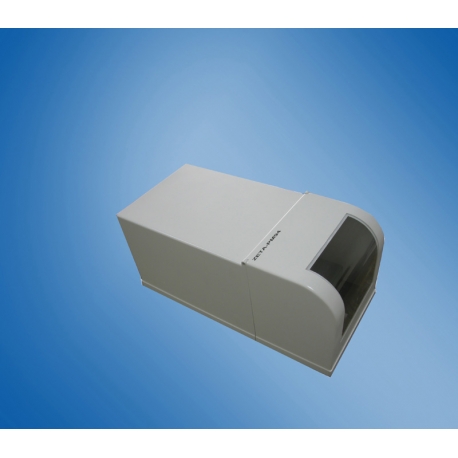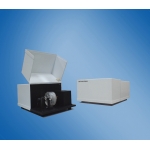ZETA Potential Analyzer
- Products
- Petroleum & Oil Testing
- Tablet Drug Tester
- Refrigeration & Cryogenic
- Life Sciences
- Laboratory
- Spectrometer
- Spray Dryer
- Rotary Evaporator
- Reactor
- Sterilizing & Cleaning
- Water Quality Analyzer
- Chemical Analysis
- Physical Testing
- Centrifuge
- Pathology Equipment
- Optical
- Ultrasonic Homogenizer
- Packaging Testers
- NDT
- Agriculture & Food
- Hazardous Chemical Detection
- Fusion Machine
- Testing Chamber
- Filter Integrity Tester
- Industry Testing Device
- Featured
Zeta potential measuring
ZETA-PM94 Series
Solid micro electrophoresis instrument (Zeta potential instrument) can be used to determine the dispersion of particulate matter - liquid interface is electrically (ζ potential), can also be used to measure the emulsion droplet interface electrical properties can also be used to determine the isoelectric point, Interfacial Reaction mechanism process.
- Remove this product from my favorite's list.
- Add this product to my list of favorites.
More info
Solid micro electrophoresis instrument (Zeta potential instrument) can be used to determine the dispersion of particulate matter - liquid interface is electrically (ζ potential), can also be used to measure the emulsion droplet interface electrical properties can also be used to determine the isoelectric point, Interfacial Reaction mechanism process. By measuring particles Zeta potential was determined isoelectric point is an important method of understanding particle surface electrical properties, surface treatment of the particles is also an important means. Compared with other similar instruments at home and abroad, it has significant advantages. It can be widely used in cosmetics, mineral processing, paper making, health care, construction materials, ultra-fine materials, environmental protection, marine chemistry and other industries, is one of chemistry, chemical engineering, medicine, building materials and other important professional teaching equipment.
At present, flow of potential Zeta potential analyzer, ultrasound Zeta potential analyzer, online Zeta potential analyzer, solid Zeta potential analyzer are being developed.
Measurement Technology Features
- The new instrument uses a simple electric pool new design, the use of 0.5cm thick glass electrode built-in pool. Electrophoresis Cup and built by the precision micro-electrode flow field, surface treatment, consisting of a swimming pool with traditional electricity completely different electrophoresis apparatus. When the test sample volume rarely, each only 0.5ml, easy to clean, easy to use, economical and practical.
- After using the electrode holder carefully designed and electrophoresis cup closely together to form a cup-shaped open-electrophoresis apparatus, an electrode using silver, platinum and titanium metal wire, after surface treatment stable working conditions.
- The well-made crosshairs after electrophoresis into the cup on the 3D platform, adjust the 3D platform, see a clear image on the computer screen of the cross, they found the measurement position, no static layer problem.
- The electrophoresis apparatus using a semiconductor light emitting near-field optical system, only tens of microwatts of power, heat will not affect the environment and measurement accuracy, and adjust the optical system to increase the magnification, the use of shorter wavelength blue light and green, so you can see the smaller particles.
- Using constant low-frequency switching power supply, it can prevent polarization, but also at the same time greatly improve the measurement speed. Positive and negative commutation time is from 0.30 to 1.20 seconds continuously adjustable sampling time only 3 to 10 seconds. Inter-electrode voltage can be adjusted as needed.
- The use of temperature sampling probe, automatic continuous sampling of the ambient temperature, return your computer to automatically adjust the parameters for calculating the Zeta potential. Use of computer multimedia technology, at a given tempo, automatically by the high magnification 1200 times continuous ultrafine particle "camera", providing two-way total of four gray image analysis and calculation.
Specifications:
Model | ZETA-PM94H micro-electrophoresis | ZETA-PM94H2 micro-electrophoresis | ZETA-PM94J enhanced micro-electrophoresis | ZETA-PM94J2 enhanced micro-electrophoresis | ZETA-PM94K | ZETA-PM94K2 |
Particles range | Suitable for 0.5 ~ 20um dispersion (aqueous system) | Suitable for 0.5 ~ 20um dispersion (aqueous and non-aqueous systems dual system type) | Suitable for 0.1 ~ 10um dispersion (aqueous system) | Suitable for 0.1 ~ 10um dispersion (aqueous and non-aqueous systems dual system type) | Suitable for 0.2 ~ 50um dispersion (aqueous system) | Suitable for 0.2 ~ 50um dispersion (aqueous and non-aqueous systems dual system type) |
pH range | Generally used in 2.0 to 12.0, also in the 1.6 to 13.0 range, step size 0.1 | |||||
temperature | 5 ℃ to 35 ℃, accuracy of 0.1 ℃, recommended to use in a thermostatic dust proof indoor environment | |||||
Usage Environment | shock proof platform | shock proof platform | shock proof platform | shock proof platform | shock proof platform | shock proof platform |
Power &voltage | 220V 50Hz | 220V 50Hz | 220V 50Hz | 220V 50Hz | 220V 50Hz | 220V 50Hz |
Power consumption | 150W | 150W | 150W | 150W | 150W | 150W |
Measurement Accuracy | System error is less than 5% | System error is less than 5% | System error is less than 5% | System error is less than 5% | System error is less than 5% | System error is less than 5% |
Optical system | Continuous zoom system is zoom optical system adapted to measure a wider range of particles | Continuous zoom system is zoom optical system adapted to measure a wider range of particles | ||||
Demarcate | You must use special calibration scale magnification for each measurement | You must use special calibration scale magnification for each measurement | ||||
Note | ZETA-PM94H2 micro electrophoresis instrument primarily measure zeta potential in non-aqueous system, particle motion in non-aqueous systems require a higher voltage, ZETA-PM94H2 designed for this type of model, but also compatible with testing zeta potential of particles in the water system. | ZETA-PM94J2 micro electrophoresis instrument primarily measure zeta potential in non-aqueous system, particle motion in non-aqueous systems require a higher voltage, ZETA-PM94H2 designed for this type of model, but also compatible with testing zeta potential of particles in the water system. | ZETA-PM94K2 | |||







